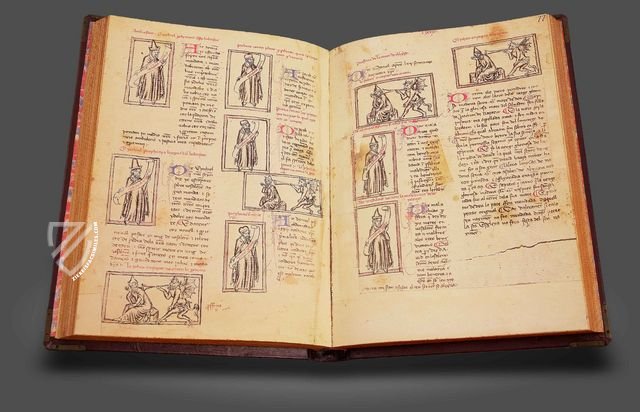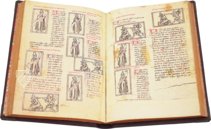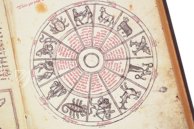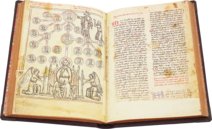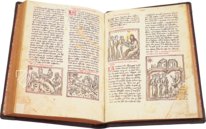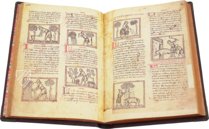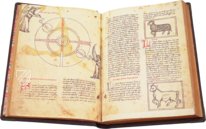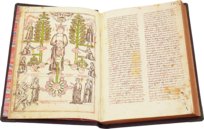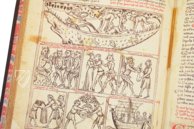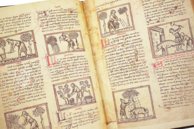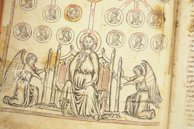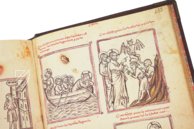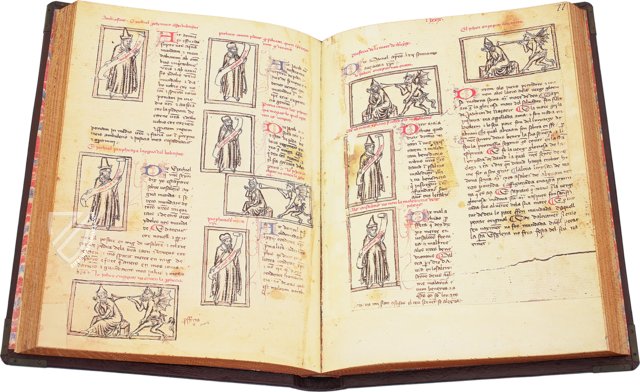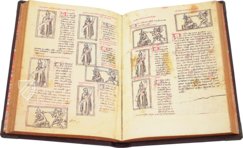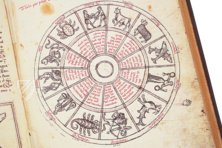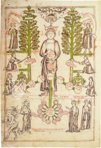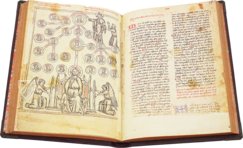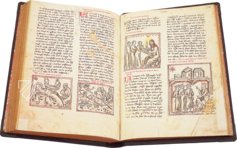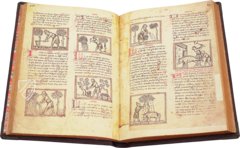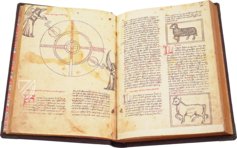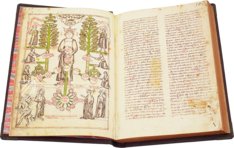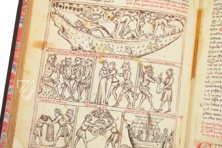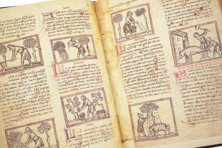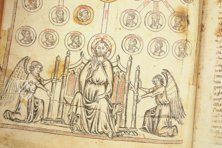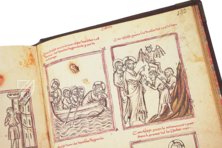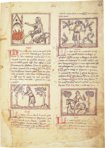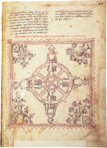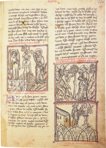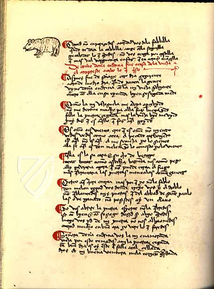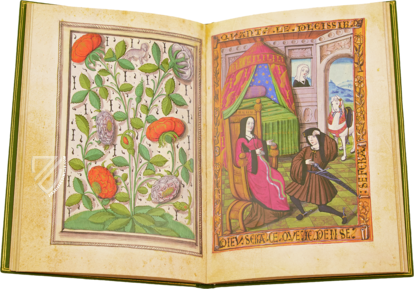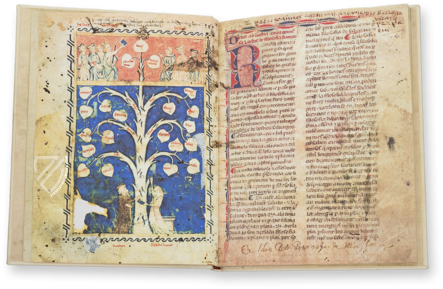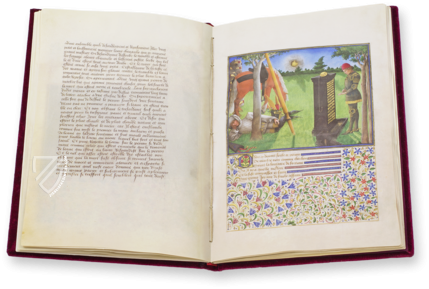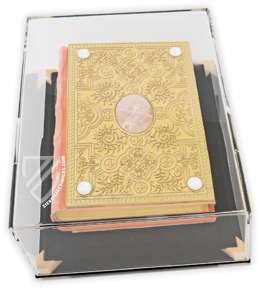Breviari d'Amor
(1,000€ - 3,000€)
Matfre Ermengaud, about whose life historians possess little information, lived in the 13th century as a Franciscan monk. The exceptionally gifted and educated monk likely composed a unique manuscript in the time period from 1288 to 1320, which united Christian theology and historic jurisprudence with the poetry of medieval Troubadours. The scholar’s incomparable masterpiece bore the title Breviari d'Amor and is considered today to be the highpoint of 12th and 13th century Occitan literature. Here we have a Spanish translation of the great literary classic.
Breviari d'Amor
By the term troubadour, one means a bard, composer, and singer of courtly medieval poetry and song. Troubadour poetry enjoyed great popularity particularly in southern France in the 12th and 13th centuries. An exceptionally gifted representative of this art form was the Franciscan monk of Matfre Ermengaud. He composed an influential text around the time period between 1288 and 1320, which in the literary genre of troubadour poetry has been cited and newly interpreted in an incomparable manner. His so-called Breviari d'Amor, which can be translated as the Book of Hours of Love, considered to be one of the most important works of Occitan poetry. The masterpiece lying before us is a 15th century Spanish translation. It is illustrated with breathtaking miniatures, which are embellished with coloring and precious gold leaf elements.
The Scholar Matfre Ermengaud
To this day, researchers know only very little information about the life of Matfre Ermengaud. He came into the world in the southern French town of Béziers in the mid–13th century. He dedicated his life to jurisprudence and poetry. He placed particularly high worth on a comprehensive education and was a true legal expert of the Middle Ages. He even earned a degree in legal studies, which could be compared with a modern master’s degree in law. Precisely when he entered the Franciscan Order is not known. He had probably already begun work on his Breviari d'Amor, before he chose the life of a monk. What lends Ermengaud’s manuscript its unique status in the history of literature is the fact that his text combines the theological tradition with legal teachings. There is no other medieval manuscript that can be compared with the work of Matfre Ermengaud.
A Literary Cultural Property
The Breviari d'Amor contains around 34,500 verses and is composed in octosyllabic rhyming couplets. It is a comprehensive, varied, and didactic text, which is comparable to an encyclopedia. The Christian love of God was formulated in the manner of love poetry, which was recited by troubadours. In doing so, Ermengaud cited literary models from various historic epochs. Citations from classic troubadours like Aimeric de Peguilhan, Bernart de Ventadorn, and Peire Vidal are particularly common in his manuscript. Equally so, quotations from a few of Ermengaud’s early writings as well as texts from his brother Piere are represented here. It is thus clear how exceptionally well-read and educated the Franciscan monk was. The Spanish edition of the literary masterpiece was made by Guillem de Copons, who strongly adhered to the original in his translation.
A Unique Work of Illumination
The work was structured into several parts. It begins with a theological section whose title can be translated as “Studies on God and the Creation of the World”. This section deals with the Holy Trinity, angels, demons, the signs of the zodiac, and the stars and planets that were known at the time. Thereupon follows a section with the title “Studies of Nature and Natural Law”, in which the correct modes for divine worship are discussed, the temptations of the world reviewed, and the sins that every good Christian should avoid at all costs are named. In the last section, “The Love of God”, the profession of faith is summarized and a few saint’s legends were outlined. Fabulous miniatures of various sizes, most of which exist as sketches, are sometimes furnished with bright colors and shimmering gold elements, illustrating the work and clarifying Ermengaud’s description.
Codicology
- Alternative Titles
- Love Breviary
Liebes-Brevier - Size / Format
- 320 pages / 40.0 × 28.0 cm
- Origin
- Spain
- Date
- 15th century
- Epochs
- Style
- Genre
- Illustrations
- More than 150 miniatures in various sizes in grisaille, but some with bright colors and shimmering gold elements
- Content
- Encyclopedic work in verse form with a special focus on the love of God
- Artist / School
- Matfre Ermengaud (author)
Guillem de Copons (translator) - Previous Owners
- Library of the count-duke of Olivares
Biblioteca Real
Gaspar Galcerán, Count of Guimerá
Breviari d'Amor
Personified Representation of February
The text states that February is a very distressing and rainy month. That is why it is represented by an old man wearing a cloak and hood who is warming his feet by the fire, the only element of this miniature to be colored. It goes on to state that February is the shortest month of the year and is thus occasionally lengthened by an additional day to adjust for leap years. The text finishes by stating that the day is given ten hours and the night fourteen hours during this month of cabin fever.
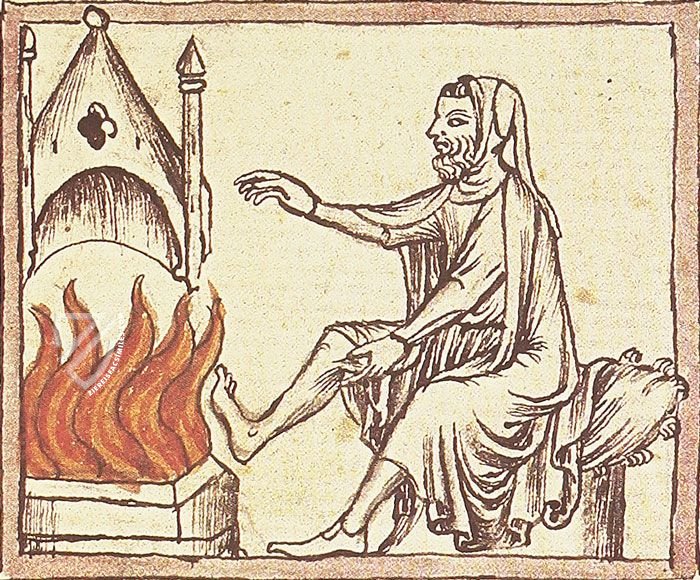
Breviari d'Amor
Tree of Love
Love, its forms, the virtues it requires, and the roots that feed and sustain it are represented by the so-called Tree of Love. Nature, created by God for the governance of living beings, is divided between natural law on the left and the law of nations on the right. The figures chopping the tree with axes represent pride and other sins that are contrary to love.
Crowned by the Holy Spirit, the great lady embodies the four forms of love. The love of God and one’s neighbor is the highest form of love, and as such is written on her crown. Love for one’s children is the warmest form of love, and thus she holds it close to her heart. Next comes romantic love, which is often driven by lust, and lastly at her feet is the love of temporal goods.
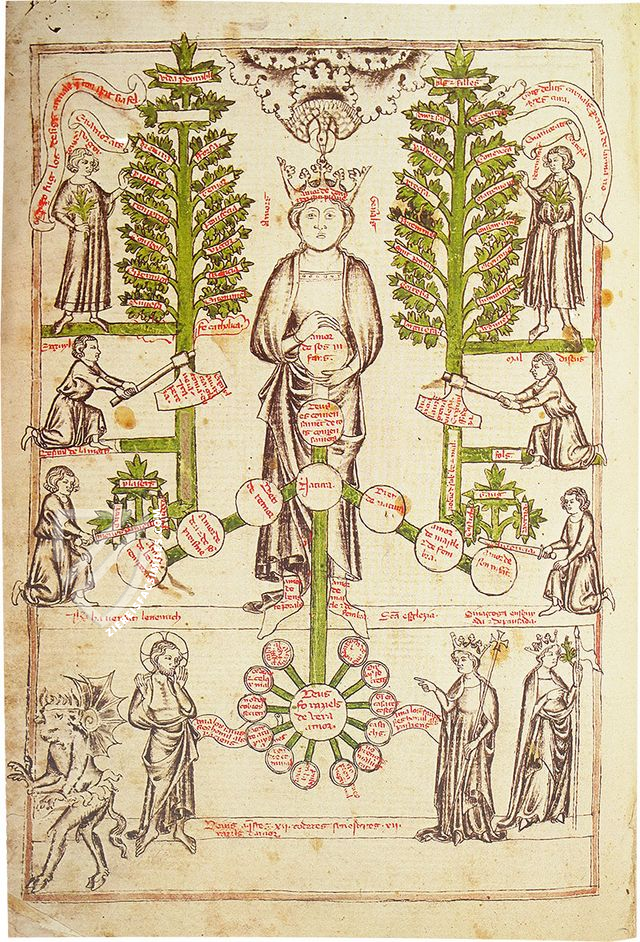
#1 Breviari d'Amor
Languages: Spanish, Valencian
(1,000€ - 3,000€)
- Treatises / Secular Books
- Apocalypses / Beatus
- Astronomy / Astrology
- Bestiaries
- Bibles / Gospels
- Chronicles / History / Law
- Geography / Maps
- Saints' Lives
- Islam / Oriental
- Judaism / Hebrew
- Single Leaf Collections
- Leonardo da Vinci
- Literature / Poetry
- Liturgical Manuscripts
- Medicine / Botany / Alchemy
- Music
- Mythology / Prophecies
- Psalters
- Other Religious Books
- Games / Hunting
- Private Devotion Books
- Other Genres
- Afghanistan
- Armenia
- Austria
- Belgium
- Belize
- Bosnia and Herzegovina
- China
- Colombia
- Costa Rica
- Croatia
- Cyprus
- Czech Republic
- Denmark
- Egypt
- El Salvador
- Ethiopia
- France
- Germany
- Greece
- Guatemala
- Honduras
- Hungary
- India
- Iran
- Iraq
- Israel
- Italy
- Japan
- Jordan
- Kazakhstan
- Kyrgyzstan
- Lebanon
- Liechtenstein
- Luxembourg
- Mexico
- Morocco
- Netherlands
- Palestine
- Panama
- Peru
- Poland
- Portugal
- Romania
- Russia
- Serbia
- Spain
- Sri Lanka
- Sweden
- Switzerland
- Syria
- Tajikistan
- Turkey
- Turkmenistan
- Ukraine
- United Kingdom
- United States
- Uzbekistan
- Vatican City
- A. Oosthoek, van Holkema & Warendorf
- Aboca Museum
- Ajuntament de Valencia
- Akademie Verlag
- Akademische Druck- u. Verlagsanstalt (ADEVA)
- Aldo Ausilio Editore - Bottega d’Erasmo
- Alecto Historical Editions
- Alkuin Verlag
- Almqvist & Wiksell
- Amilcare Pizzi
- Andreas & Andreas Verlagsbuchhandlung
- Archa 90
- Archiv Verlag
- Archivi Edizioni
- Arnold Verlag
- ARS
- Ars Magna
- ArtCodex
- AyN Ediciones
- Azimuth Editions
- Badenia Verlag
- Bärenreiter-Verlag
- Belser Verlag
- Belser Verlag / WK Wertkontor
- Benziger Verlag
- Bernardinum Wydawnictwo
- BiblioGemma
- Biblioteca Apostolica Vaticana (Vaticanstadt, Vaticanstadt)
- Bibliotheca Palatina Faksimile Verlag
- Bibliotheca Rara
- Boydell & Brewer
- Bramante Edizioni
- Bredius Genootschap
- Brepols Publishers
- British Library
- C. Weckesser
- Caixa Catalunya
- Canesi
- CAPSA, Ars Scriptoria
- Caratzas Brothers, Publishers
- Carus Verlag
- Casamassima Libri
- Centrum Cartographie Verlag GmbH
- Chavane Verlag
- Christian Brandstätter Verlag
- Circulo Cientifico
- Club Bibliófilo Versol
- Club du Livre
- CM Editores
- Collegium Graphicum
- Collezione Apocrifa Da Vinci
- Comissão Nacional para as Comemorações dos Descobrimentos Portugueses
- Coron Verlag
- Corvina
- CTHS
- D. S. Brewer
- Damon
- De Agostini/UTET
- De Nederlandsche Boekhandel
- De Schutter
- Deuschle & Stemmle
- Deutscher Verlag für Kunstwissenschaft
- DIAMM
- Droz
- E. Schreiber Graphische Kunstanstalten
- Ediciones Boreal
- Ediciones Grial
- Ediclube
- Edições Inapa
- Edilan
- Editalia
- Edition Deuschle
- Edition Georg Popp
- Edition Leipzig
- Edition Libri Illustri
- Editiones Reales Sitios S. L.
- Éditions de l'Oiseau Lyre
- Editions Medicina Rara
- Editorial Casariego
- Editorial Mintzoa
- Editrice Antenore
- Editrice Velar
- Edizioni Edison
- Egeria, S.L.
- Eikon Editores
- Electa
- Emery Walker Limited
- Enciclopèdia Catalana
- Eos-Verlag
- Ephesus Publishing
- Ernst Battenberg
- Eugrammia Press
- Extraordinary Editions
- Fackelverlag
- Facsimila Art & Edition
- Facsimile Editions Ltd.
- Facsimilia Art & Edition Ebert KG
- Faksimile Verlag
- Feuermann Verlag
- Folger Shakespeare Library
- Franco Cosimo Panini Editore
- Friedrich Wittig Verlag
- Fundación Hullera Vasco-Leonesa
- G. Braziller
- Gabriele Mazzotta Editore
- Gebr. Mann Verlag
- Gesellschaft für graphische Industrie
- Getty Research Institute
- Giovanni Domenico de Rossi
- Giunti Editore
- Graffiti
- Grafica European Center of Fine Arts
- Guido Pressler
- Guillermo Blazquez
- Gustav Kiepenheuer
- H. N. Abrams
- Harrassowitz
- Harvard University Press
- Helikon
- Hendrickson Publishers
- Henning Oppermann
- Herder Verlag
- Hes & De Graaf Publishers
- Hoepli
- Holbein-Verlag
- Houghton Library
- Hugo Schmidt Verlag
- Idion Verlag
- Il Bulino, edizioni d'arte
- ILte
- Imago
- Insel Verlag
- Insel-Verlag Anton Kippenberger
- Instituto de Estudios Altoaragoneses
- Instituto Nacional de Antropología e Historia
- Introligatornia Budnik Jerzy
- Istituto dell'Enciclopedia Italiana - Treccani
- Istituto Ellenico di Studi Bizantini e Postbizantini
- Istituto Geografico De Agostini
- Istituto Poligrafico e Zecca dello Stato
- Italarte Art Establishments
- Jan Thorbecke Verlag
- Johnson Reprint Corporation
- Josef Stocker
- Josef Stocker-Schmid
- Jugoslavija
- Karl W. Hiersemann
- Kasper Straube
- Kaydeda Ediciones
- Kindler Verlag / Coron Verlag
- Kodansha International Ltd.
- Konrad Kölbl Verlag
- Kurt Wolff Verlag
- La Liberia dello Stato
- La Linea Editrice
- La Meta Editore
- Lambert Schneider
- Landeskreditbank Baden-Württemberg
- Leo S. Olschki
- Les Incunables
- Liber Artis
- Library of Congress
- Libreria Musicale Italiana
- Lichtdruck
- Lito Immagine Editore
- Lumen Artis
- Lund Humphries
- M. Moleiro Editor
- Maison des Sciences de l'homme et de la société de Poitiers
- Manuscriptum
- Martinus Nijhoff
- Maruzen-Yushodo Co. Ltd.
- MASA
- Massada Publishers
- McGraw-Hill
- Metropolitan Museum of Art
- Militos
- Millennium Liber
- Müller & Schindler
- Nahar - Stavit
- Nahar and Steimatzky
- National Library of Wales
- Neri Pozza
- Nova Charta
- Oceanum Verlag
- Odeon
- Orbis Mediaevalis
- Orbis Pictus
- Österreichische Staatsdruckerei
- Oxford University Press
- Pageant Books
- Parzellers Buchverlag
- Patrimonio Ediciones
- Pattloch Verlag
- PIAF
- Pieper Verlag
- Plon-Nourrit et cie
- Poligrafiche Bolis
- Presses Universitaires de Strasbourg
- Prestel Verlag
- Princeton University Press
- Prisma Verlag
- Priuli & Verlucca, editori
- Pro Sport Verlag
- Propyläen Verlag
- Pytheas Books
- Quaternio Verlag Luzern
- Reales Sitios
- Recht-Verlag
- Reichert Verlag
- Reichsdruckerei
- Reprint Verlag
- Riehn & Reusch
- Roberto Vattori Editore
- Rosenkilde and Bagger
- Roxburghe Club
- Salerno Editrice
- Saltellus Press
- Sandoz
- Sarajevo Svjetlost
- Schöck ArtPrint Kft.
- Schulsinger Brothers
- Scolar Press
- Scrinium
- Scripta Maneant
- Scriptorium
- Shazar
- Siloé, arte y bibliofilia
- SISMEL - Edizioni del Galluzzo
- Sociedad Mexicana de Antropología
- Société des Bibliophiles & Iconophiles de Belgique
- Soncin Publishing
- Sorli Ediciones
- Stainer and Bell
- Studer
- Styria Verlag
- Sumptibus Pragopress
- Szegedi Tudomànyegyetem
- Taberna Libraria
- Tarshish Books
- Taschen
- Tempus Libri
- Testimonio Compañía Editorial
- Thames and Hudson
- The Clear Vue Publishing Partnership Limited
- The Facsimile Codex
- The Folio Society
- The Marquess of Normanby
- The Richard III and Yorkist History Trust
- Tip.Le.Co
- TouchArt
- TREC Publishing House
- TRI Publishing Co.
- Trident Editore
- Tuliba Collection
- Typis Regiae Officinae Polygraphicae
- Union Verlag Berlin
- Universidad de Granada
- University of California Press
- University of Chicago Press
- Urs Graf
- Vallecchi
- Van Wijnen
- VCH, Acta Humaniora
- VDI Verlag
- VEB Deutscher Verlag für Musik
- Verlag Anton Pustet / Andreas Verlag
- Verlag Bibliophile Drucke Josef Stocker
- Verlag der Münchner Drucke
- Verlag für Regionalgeschichte
- Verlag Styria
- Vicent Garcia Editores
- W. Turnowski Ltd.
- W. Turnowsky
- Waanders Printers
- Wiener Mechitharisten-Congregation (Wien, Österreich)
- Wissenschaftliche Buchgesellschaft
- Wissenschaftliche Verlagsgesellschaft
- Wydawnictwo Dolnoslaskie
- Xuntanza Editorial
- Zakład Narodowy
- Zollikofer AG

